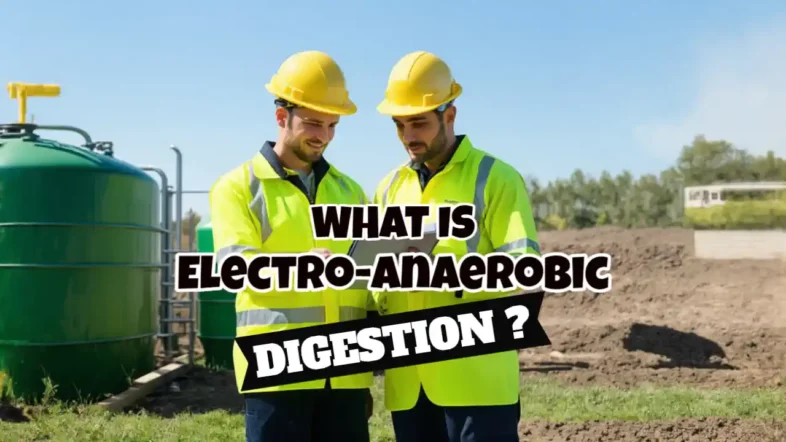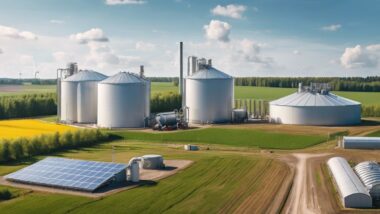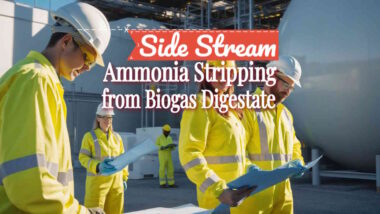Have you ever wondered what happens to food scraps, animal manure, and other organic waste? Traditional methods like composting and landfilling often result in greenhouse gas emissions and wasted energy, so many governments now encourage local authorities and businesses to send this waste to anaerobic digestion facilities.
However, a newer method that builds upon current anaerobic digestion methods called electro-anaerobic digestion (EAD) could offer a more efficient solution.
Recent studies show that EAD can outperform conventional anaerobic digestion by reducing carbon footprints and doubling biomethane production from waste. This means not only less pollution but also more green energy generated. 1
In this article, we will explore how EAD works compared to traditional methods. We will also discuss the environmental benefits, cost efficiency, and potential for wider adoption. Stay tuned! 2
Key Takeaways
- Electro-anaerobic digestion (EAD) merges traditional anaerobic processes with electrochemical techniques, boosting methane production and reducing greenhouse gas emissions by up to 42.6%.
- EAD systems improve energy conversion efficiency by 27.7% to 74.3%, offering a significant advantage over conventional methods.
- Methane yield from organic waste, such as food scraps and animal manure, increases significantly in EAD systems due to enhanced microbial activity under electrical conditions.
- The process substantially reduces the carbon footprint of waste treatment facilities, reaching emission levels as low as 6.2 g CO2-eq MJ−1 under decarbonised electricity grids.
- Countries like China could enhance their biomethane resources dramatically through EAD technology, potentially producing enough biomethane to cover up to 82.6% of their natural gas consumption needs.
Definition and Overview of Electro-Anaerobic Digestion

1. Introduction
Electro-anaerobic digestion represents a promising advancement in the quest for sustainable energy solutions, merging traditional anaerobic digestion processes with innovative electrochemical techniques.
This hybrid method enhances biogas production, offering a significant step forward in environmental management and renewable energy generation. 1
2. Definition and Overview of Electro-Anaerobic Digestion
Electro-anaerobic digestion combines standard anaerobic digestion (AD) with external electrical inputs to boost methane generation from organic waste. By introducing an electric field into the process, this technique utilises microbial electrolysis cells (MECs) to enhance methanogenic activity efficiently.
The applied voltage across the system results in higher methane yields and better productivities compared to conventional methods. 2
This approach not only increases the specific methane yield but also optimises energy conversion efficiency by 27.7%–74.3%. Additionally, it significantly reduces primary energy consumption and carbon footprint within the range of 18%–42.6%.
With methane content reaching levels equal or greater than 70%, this method shows substantial promise for improving both biogas quality and overall production performance. 1
The integration of advanced electrochemistry into biodigesters aligns well with current goals for decarbonisation of electricity and alternative sources of energy, presenting viable pathways towards more efficient natural gas consumption and reduced global warming potential.
Conventional Anaerobic Digestion vs. Electro-Anaerobic Digestion
| Criteria | Conventional Anaerobic Digestion | Electro-Anaerobic Digestion |
|---|---|---|
| Energy Consumption | Higher energy use | Reduced by 21.7%–42.6% |
| Carbon Footprint | Higher carbon emissions | Decreased by 18.0%–42.6% |
| Energy Conversion Ratio | Lower efficiency | Increased by 27.7%–74.3% |
| Methane Yield | Lower methane production | Higher methane quality and yield |
| Environmental Impact | Less favourable | Outperformed conventional methods |
| Organic Solid Waste Treatment | Less efficient | Improved treatment efficiency |
| Industrialisation Potential | Widely adopted | Higher potential for future adoption |
Conventional anaerobic digestion (AD) has lower energy conversion efficiency. 1 Electro-anaerobic digestion (EAD) systems show significant improvements.
- Energy consumption in EAD systems is reduced drastically.
- Carbon footprints decrease substantially.
- Methane yields are higher in EAD, ensuring better quality.
- EAD systems excel in environmental performance. Organic solid waste treatment is more efficient using EAD. 2 AI and machine learning could optimise EAD processes further.
Overall, EAD systems present a viable, advanced alternative.

Benefits of Electro-Anaerobic Digestion
Electro-anaerobic digestion (EAD) offers several advantages over traditional methods. It significantly enhances the removal of volatile solids, resulting in cleaner and more efficient waste treatment.
Moreover, methane production rates improve drastically with EAD technology. This increase is due to the promotion of direct interspecies electron transfer (DIET), which speeds up the conversion of volatile fatty acids to methane. 3
Bioaugmentation with electrochemically active microbes further enriches this process. These microbes bolster resilience against kinetic imbalances, making the system more robust under varying conditions. 3 Additionally, EAD systems deliver higher biogas methane content and yield compared to conventional anaerobic digesters—boosting overall efficiency in energy recovery from organic solid waste treatments while also reducing carbon footprints effectively through enhanced feedstock conversion efficiency and reduced chemical oxygen demand (COD). 4

Energy Conversion Efficiency
Electro-anaerobic digestion (EAD) boosts the energy conversion ratio significantly. The process uses an electric field to improve the breakdown of organic waste. 4 This leads to a rise in efficiency by 27.7% to 74.3%.
Higher rates mean more biogas is produced, which can be turned into useful energy like electricity or biomethane.
The highest recorded energy conversion ratio in EAD reached 12.8 with animal manure, showing its strong potential for farming applications. By enhancing anaerobic digestion with electricity, EAD could double the amount of biomethane obtained from wastes. 2 This increased output means less reliance on fossil fuels and a step toward better sustainability practices in waste management and energy sectors.
Reduction in Carbon Footprint
The carbon footprint of electro-anaerobic digestion (EAD) systems has seen significant reductions. These reductions range between 18% to 42.6%, showcasing the potential for lowering greenhouse gas emissions.
This is especially relevant as the future electricity market aims for complete decarbonisation. With this goal, biomethane can achieve an emission level as low as 6.2 g CO2-eq MJ−1. 5
The process also demonstrates impressive results in specific applications, like the treatment of animal manure, which shows a global warming potential of 39.6 g CO2-eq MJ−1. Given that conventional methods produce higher emissions, EAD provides a more sustainable alternative.
Such improvements not only help combat climate change but also position EAD as a viable method in waste management strategies. 6
Methane yield and quality further solidify its advantages…
Methane Yield and Quality
Methane yield and quality improve significantly with electro-anaerobic digestion (EAD). Applying voltage to the reactor boosts methane content, reaching levels equal to or greater than 70%.
This surpasses the results from reactors without voltage. Specific methane yields vary with different organic solid wastes like food waste, animal manure, and dry straw. The composition of these substrates affects how well they respond to pretreatment.
Higher specific methane yields occur due to enhanced microbial activity in EAD systems. Methanogenic archaea thrive under voltage application, leading to better biogas production performance.
These microbes convert more organic compounds into biomethane when electricity is present. This process not only increases efficiency but also improves the overall quality of biogas generated in these systems. 1 7
Impact on Organic Solid Waste Treatment
Electro-anaerobic digestion (EAD) boosts the treatment of organic solid waste. This technique enhances degradation rates of lignin and cellulose in straw by 12.6% and 9.4%, respectively, when voltage is applied to the reactor.
With this increased breakdown efficiency, more organic matter gets converted into biogas. 1
In China, EAD can theoretically produce biomethane equal to 82.6% of natural gas consumption. This significant potential could double biomethane resources derived from waste materials.
By converting kitchen wastes and agricultural residues through electrolysis, landfill use decreases sharply while energy recovery improves dramatically. 8
Experimental Studies and Findings
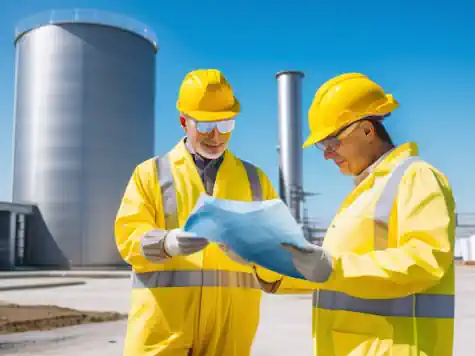 Experimental studies reveal significant improvements in anaerobic digestion after applying voltage. Researchers noticed that the methane content reached or even exceeded 70% in reactors with applied voltage. 10 This enhanced performance is crucial for more efficient biogas production and supports the generation of biomethane, a clean energy alternative.
Experimental studies reveal significant improvements in anaerobic digestion after applying voltage. Researchers noticed that the methane content reached or even exceeded 70% in reactors with applied voltage. 10 This enhanced performance is crucial for more efficient biogas production and supports the generation of biomethane, a clean energy alternative.
Increased degradation rates were another positive outcome. The breakdown of lignin and cellulose in straw improved by 12.6% and 9.4%, respectively, when voltage was introduced to the system.
Enhanced degradation rates mean faster conversion of organic waste into valuable gases like methane and hydrogen, aiding both waste management and energy recovery efforts.
Sensitivity analyses highlighted that changes in specific methane yield had the most substantial impact on system performance. 9 These findings underscore the importance of optimising conditions to maximise methane production while reducing parasitic demand within microbial electrolysis cells (MEC).
Effective results can contribute greatly to resource recovery processes, making landfill dependency less critical and promoting sustainable practices within biorefineries.
Potential for Industrialisation
Electro-anaerobic digestion (EAD) holds great promise for large-scale biomethane production. Supported by the Department of Science & Technology in New Delhi, this technology harnesses renewable energy for creating clean biogas. 11 The process involves microbial electrolysis cells (MEC), which boost methane yield and quality. This efficient method converts organic solid waste into valuable biogas, reducing reliance on fossil fuels like coal.
Countries investing in green technologies may find EAD particularly beneficial. With its ability to lower carbon dioxide emissions, EAD supports decarbonisation goals and sustainable development.
Funding from national science departments, as seen in India, makes this advanced waste treatment a viable option for future energy projects. This highlights the potential of EAD systems to transform organic waste management and renewable energy sectors globally. 12
Additional Considerations for EAD
Life cycle assessment (LCA) examines the environmental impacts of EAD systems. Economic viability and investment benefits call for thorough evaluation.
Life Cycle Assessment (LCA) of EAD Systems
Electro-Anaerobic Digestion (EAD) systems are creating significant buzz. They offer the potential to reduce carbon footprints and improve energy efficiency.
- Energy Consumption
EAD systems cut energy use by 21.7% to 42.6% compared with traditional methods. This efficiency helps make the process more sustainable. 8
- Carbon Footprint Reduction
Carbon emissions drop by 18.0% to 42.6%. The reduction depends on various factors, including electricity decarbonisation.
- Energy Conversion Ratio
These systems boost the ratio of converted energy by 27.7% to 74.3%. Better conversion rates mean more efficient methane production.
- Methane Yield Sensitivity Analysis
Changes in specific methane yield significantly impact system performance. Higher yields lead to improved efficiency and reduced costs.
- Future Greenhouse Gas Emissions
Predicted future reductions show greenhouse gas emissions as low as 6.2 g CO2-eq MJ−1 under a fully decarbonised electricity grid. 8
- System Performance Comparison
Studies comparing conventional and electro-anaerobic digestion underline better overall performance for EAD systems in biomethane generation. 13
- Environmental Impacts
Lower emissions and better energy utilisation lessen environmental damage, making EAD systems eco-friendlier options than incineration or landfills.
- Economic Viability
Even with potentially higher initial investments, long-term savings from lower operational costs make EAD systems economically attractive for investors.
- Microbial Electrolysis Cell (MEC) Role
MECs assist in boosting hydrogen production, which can further enhance methane quality through biogas upgrading processes.
- Acidogenesis and Acetogenesis Processes
Acidogenic bacteria play a role in breaking down organic matter faster, aided by electrical conductivity that accelerates metabolism stages like acetogenesis.
- Exoelectrogens Activity
Exoelectrogens contribute by facilitating electron transfer, thereby improving the efficiency of anaerobic digestate treatment processes.
- Statistical Analysis Outcomes
Data analysed show strong linear relationships and correlations between operational metrics like electrical input and biomethane output efficiency.
Environmental Impacts and Sustainability
Electro-anaerobic digestion (EAD) lowers greenhouse gas emissions by converting farm animal manure into energy. The process produces biomethane, a non-fossil fuel, which helps in the decarbonisation of electricity.
A life cycle assessment (LCA) shows that EAD systems outperform traditional methods in reducing environmental impact. 15
Using technologies like microbial fuel cells and hydrothermal carbonisation, EAD not only boosts methane yield but also enhances the quality of biogas produced. Valorising food waste through this method generates biodiesel and biohydrogen, addressing waste management problems while providing renewable energy sources.
This contributes to a smaller carbon footprint and promotes sustainable practices in organic solid waste treatment. 14
Economic Viability and Investment Opportunities
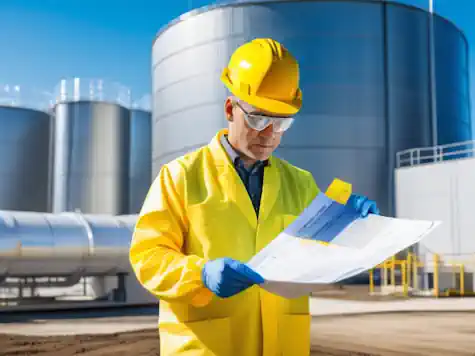 Investing in electro-anaerobic digestion (EAD) offers promising economic benefits. High fertiliser prices can increase the value of digestate, which enhances overall viability. 16 Renewable energy from electromethanogenesis is seen as a cost-effective option for future projects.
Investing in electro-anaerobic digestion (EAD) offers promising economic benefits. High fertiliser prices can increase the value of digestate, which enhances overall viability. 16 Renewable energy from electromethanogenesis is seen as a cost-effective option for future projects.
Analyses show that combinations of support levels, energy prices, and capital costs make EAD an attractive choice.
Capitalising on subsidy-free viability became achievable with high energy prices in late 2021. Investors are drawn to this technology due to its potential for efficient methanisation of organic solid waste in biogas plants.
The internal rate of return (IRR) and value derived from solid biofuels further boost investment appeal. 17
Conclusion
It is claimed that electro-anaerobic digestion improves energy conversion. It cuts carbon emissions and increases methane yield from waste. This method appears to be simple to do as it appears to be possible to retrofit the anodes and cathodes needed for better efficiency.
Researchers predict lower greenhouse gas emissions with this technology. The potential for industrial use is significant, making it appear to be a valuable investment opportunity in waste management.
However, the concept is new and more research is needed before these early results can be confirmed. Until then our view would be that in the past many researchers have run studies on the use of electrodes for enhancing aerobic water treatment, and yet no products that we know of are sold in this parallel technology. It is not immediately apparent why the use of electrodes would not be in use in aerobic treatment if the results are so positive.
FAQs
1. What is generative AI for marketing?
Generative AI for marketing is a form of artificial intelligence used to create content, analyse customer data, and automate content creation.
2. How can businesses use generative AI?
Businesses can use generative AI to assist in keyword research, predict consumer behaviour, implement marketing automation strategies and personalise customer interactions.
3. Can generative AI help with creating market research material?
Yes, the large language models using Generative AI helps businesses identify SEO-friendly keywords and generate other marketing materials from up-to-date information for effective market research.
4. Do I need human oversight if I implement generative AI in my business?
While automating with generative AI promises efficiency in analysing data and predicting outcomes, having human oversight ensures the produced outputs meet quality standards relevant to your intended audience.
5. Does Generative AI only work on text-based applications?
No! Beyond creating text content based on SEO-centred keyword research; it could also be applied creatively by software developers to produce highly realistic images or product demo videos.
1. What is electro-anaerobic digestion?
Electro-anaerobic digestion uses anodes and cathodes to break down organic matter without oxygen to produce methane gas.
2. How does electro-anaerobic digestion help decarbonise electricity production?
It reduces carbon emissions by converting waste into energy through pyrolysis while using electromagnetic fields like Lorentz force during the process.
3. Can this method improve waste disposal systems?
Yes! It aids in efficient disposal by breaking down proteins and saccharides syntrophically without requiring oxygen.
4. Why do researchers conduct techno-economic analysis on this method?
They want to ensure that producing methane through this technique is cost-effective compared with traditional methods.
References
- ^ https://www.sciencedirect.com/science/article/abs/pii/S1364032124000704
- ^ https://www.researchgate.net/publication/380250571_A_comparative_life_cycle_assessment_of_electro-anaerobic_digestion_to_evaluate_biomethane_generation_from_organic_solid_waste
- ^ https://www.mdpi.com/2311-5637/9/11/988
- ^ https://www.ncbi.nlm.nih.gov/pmc/articles/PMC9182473/
- ^ https://www.sciencedirect.com/science/article/am/pii/S0959652622051526
- ^ https://www.ncbi.nlm.nih.gov/pmc/articles/PMC9916134/
- ^ https://www.nature.com/articles/s41598-024-51603-9
- ^ https://www.newswise.com/articles/a-comparative-life-cycle-assessment-of-electro-anaerobic-digestion-to-evaluate-biomethane-generation-from-organic-solid-waste
- ^ https://www.researchgate.net/publication/51883418_A_critical_review_of_experimental_and_predicted_methane_generation_from_anaerobic_codigestion
- ^ https://www.sciencedirect.com/science/article/abs/pii/S0043135421005236
- ^ https://www.sciencedirect.com/science/article/abs/pii/S0045653521023584
- ^ https://www.ncbi.nlm.nih.gov/pmc/articles/PMC8973982/
- ^ https://www.researchgate.net/publication/337629448_Life_cycle_assessment_of_anaerobic_digestion_systems_Current_knowledge_improvement_methods_and_future_research_directions
- ^ https://www.researchgate.net/publication/361330638_Environmental_implications_potential_value_and_future_of_food-waste_anaerobic_digestate_management_A_review
- ^ https://www.acornbioenergy.com/perspectives/how-environmentally-sustainable-is-anaerobic-digestion (2024-01-19)
- ^ https://www.mdpi.com/2227-9717/10/2/212
- ^ https://www.researchgate.net/publication/338753443_Economic_Feasibility_Study_of_Colorado_Anaerobic_Digester_Projects_Prepared_for_the_Colorado_Governor%27s_Energy_Office

